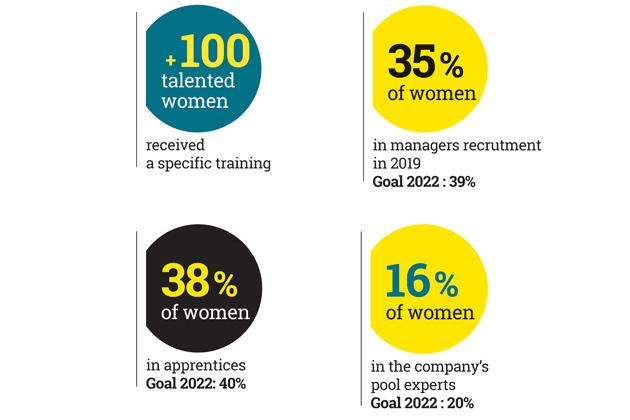
Gender equality on pay
In matters of equality, the group has always demonstrated a proactive commitment. Since last year, every company has had the obligation to compile an index of "Gender equality on pay". The results for 2019 show figures which are an improvement in almost all group entities.

Légend : Figures taken from the index on Gender equality in the workplace for 2019
Strengthening the position of women within Orano is something that the senior management of the group is strongly committed to. This is a longstanding commitment, which Orano opted to pursue further with the signature in April 2019 of an agreement relating to gender equality in the workplace by Philippe Knoche and all of the five trade union organizations representing employees at group level.
Since September 5, 2018, the law "For freedom of choice in matters of employment and career development", requires companies to compile an index of "Gender equality on pay" for every company with more than 50 employees. Calculated based on specific indicators, this index must be published and accessible to all.

A deployment in three phases
2019 was a transition year, with three planned phases of implementation and publication:
- companies with more than 1,500 employees in March 2019,
- companies with between 250 and 1,499 employees in November 2019,
- companies with between 50 and 249 employees in March 2020,
From now on, as of 2020, this index will be compiled annually for all companies with more than 50 employees.
What is the benefit of this law?
In the past, numerous legal provisions stipulated obligations of means within the framework of collective bargaining. This “Avenir” law passed in 2018 creates an obligation of results for the compagnies concerned including, amongst other things, the need to compile an index calculated based on 5 indicators. If a company does not obtain the minimal score of 75 out of 100, it will have to draw up and deploy an action plan to obtain the required score within 3 years subject to the imposition of a penalty corresponding to 1% of the payroll of the company concerned should it fail to do so.
What concrete steps are being taken?
With 3 agreements already signed in the past, Orano already met the requirements of the majority of the indicators. Since 2010, the Equality of Opportunities and Diversity Department has deployed:
- concrete plans of action such as recruiting more women,
- the identification of talented women,
- training fields by Orano University for talented women,
- budgets for pay alignment in the case of an unjustified difference for equivalent responsibilities,
- as well as increasing the number of women in the company's pool of experts.
Worth knowing
The law "for freedom of choice in matters of employment and career development" was passed by the French National Assembly by a clear majority on August 1, 2018 and was enacted by the President of the French Republic on September 5, 2018.
The "#Avenirpro" law introduces reforms in the area of work/study programs and vocational training. It also includes measures on gender equality (increasing the number of women in governance-index of gender equality in the workplace and the prevention of sexist behaviors), the employment of people with disabilities, the extension of unemployment insurance and combating fraud in relation to posted workers.
What are these 5 indicators?
- Indicator 1
Measures the average pay gap between women and men, by occupational category (Blue-collar / Clerical & service workers / Technical and Supervisory [Intermediate categories] / Engineers and Managers) and by age group (under 30s - 31 to 39 - 40 to 49 and over 49s). This first indicator is evaluated on a maximum of 40 points.
- Indicator 2
Measures the gap between the rate of individual increases between women and men, by broad occupational category. This second indicator is evaluated on a maximum of 20 points.
- Indicator 3
Measures the gap between the rate of promotions (change of classification or position), between women and men, by broad occupational category. This third indicator is evaluated on a maximum of 15 points.
- Indicator 4
Measures the percentage of employees benefitting from a pay rise in a year in which they return from maternity leave. This fourth indicator is evaluated on a maximum of 15 points.
- Indicator 5
Measures the number of employees belonging to the least represented gender featuring among the 10 highest paid employees. This last indicator is evaluated on a maximum of 10 points.